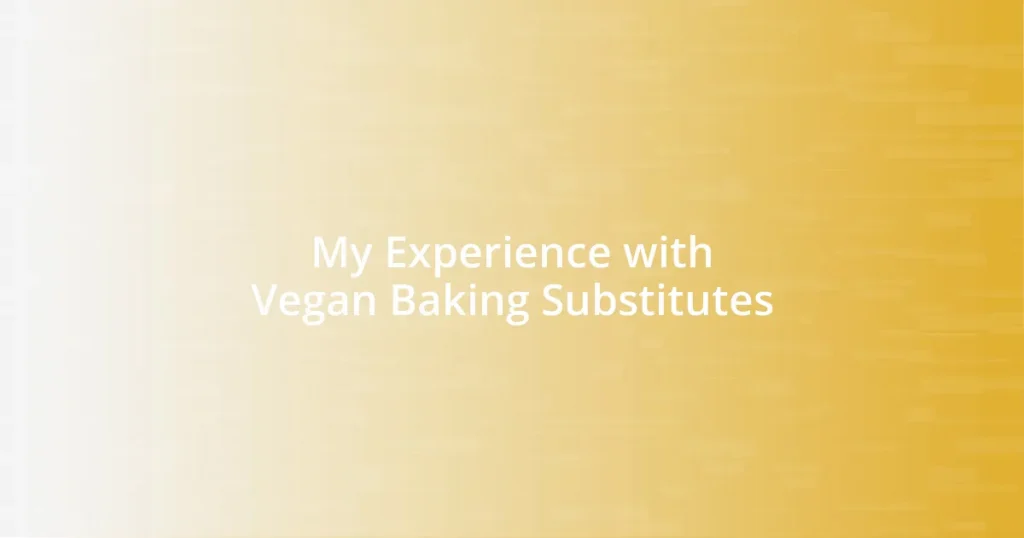Key takeaways:
- Flaxseed meal and aquafaba are effective egg substitutes that enhance texture and flavor in vegan baking.
- Using non-dairy milks like almond and oat milk can significantly elevate the taste and richness of baked goods.
- Natural sweeteners such as maple syrup and dates replace refined sugar, adding unique flavors and health benefits.
- Understanding ingredient temperatures and adjusting sweetness levels can greatly improve the outcomes of vegan recipes.
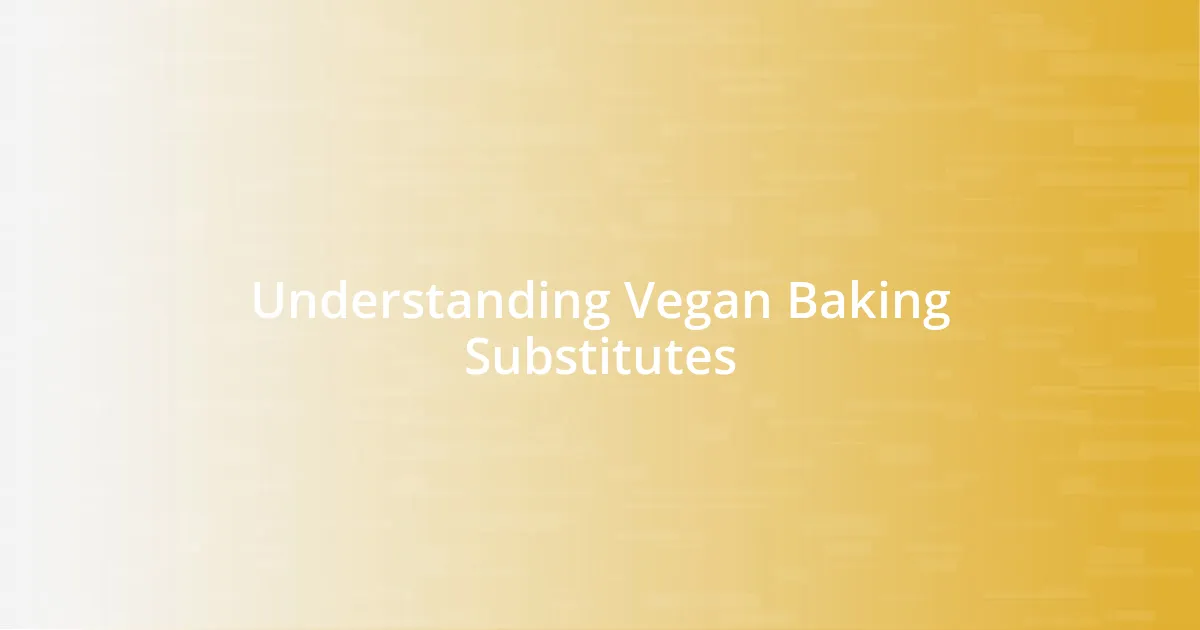
Understanding Vegan Baking Substitutes
When I first transitioned to vegan baking, I was amazed at the range of substitutes available. For instance, I often use flaxseed meal as an egg replacer. Just mixing a tablespoon of flaxseed with three tablespoons of water creates a gel-like consistency that binds ingredients beautifully. Have you ever tried experimenting with it? The result often surprised me, providing a lovely texture that I didn’t expect.
Another interesting substitute I’ve come across is aquafaba, the liquid from canned chickpeas. I’ve whipped it to soft peaks for meringues and found it performs remarkably well! Isn’t it fascinating how a humble pantry item can mimic egg whites so effectively? Each time I create something new with aquafaba, it feels like unlocking a secret cooking hack that makes vegan baking so rewarding.
For dairy replacements, I often gravitate toward almond or coconut milk in recipes, but I also love using cashew cream for richer desserts. It’s creamy and adds a depth of flavor that elevates my baked goods. Have you felt that moment when you take a bite and realize that vegan doesn’t just equal guilt-free, but also wonderfully delicious? That’s what keeps me coming back for more experiments in the kitchen.
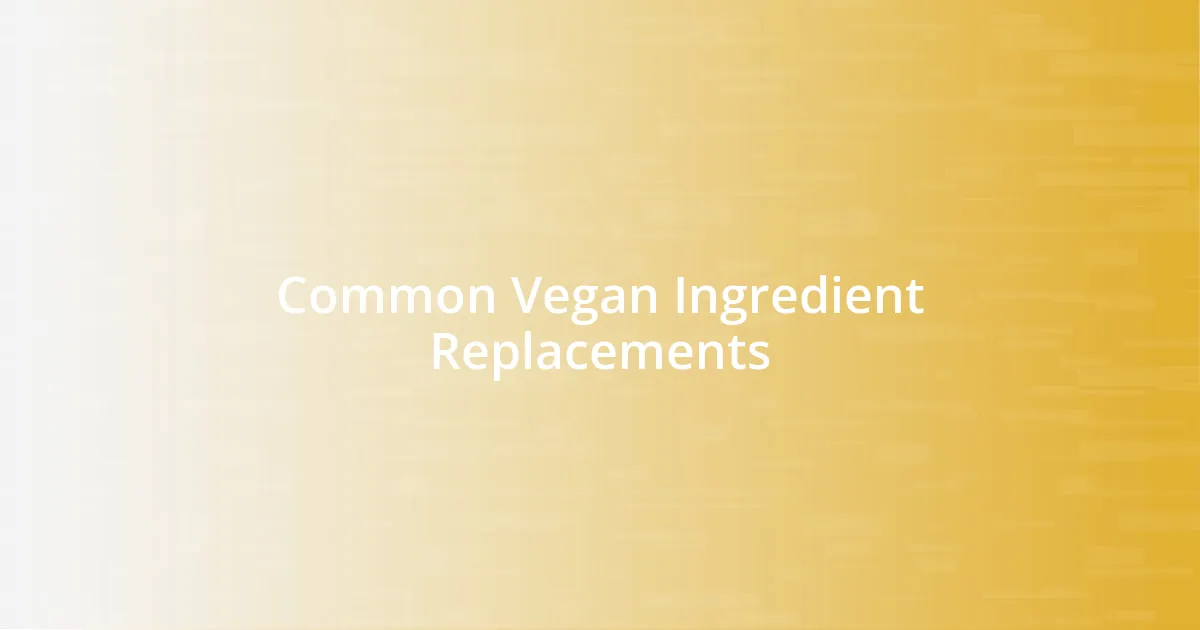
Common Vegan Ingredient Replacements
When I think about common vegan ingredient replacements, a few staples come to mind that have truly transformed my baking. One of my favorites is coconut oil; it adds a subtle richness and texture that can mimic butter beautifully. I remember one occasion when I swapped butter for coconut oil in a chocolate chip cookie recipe, and the result was a batch that disappeared in minutes. The coconut undertone thrilled my friends, and I felt like I had struck gold with that simple substitution.
Here are some common ingredient replacements that have worked wonders for me:
- Eggs: Flaxseed meal (1 tbsp flaxseed + 3 tbsp water) or chia seeds (1 tbsp chia + 2.5 tbsp water)
- Butter: Coconut oil, vegan margarine, or applesauce (for a lighter option)
- Milk: Almond milk, oat milk, or soy milk
- Cream: Cashew cream or coconut cream for a rich flavor
- Sugar: Maple syrup or agave nectar for a liquid sweetener alternative
It’s like every time I make substitutions, I unlock a new dimension of flavors and textures in my creations. I love the challenge and excitement of vegan baking—it’s like a culinary adventure that I never want to end!
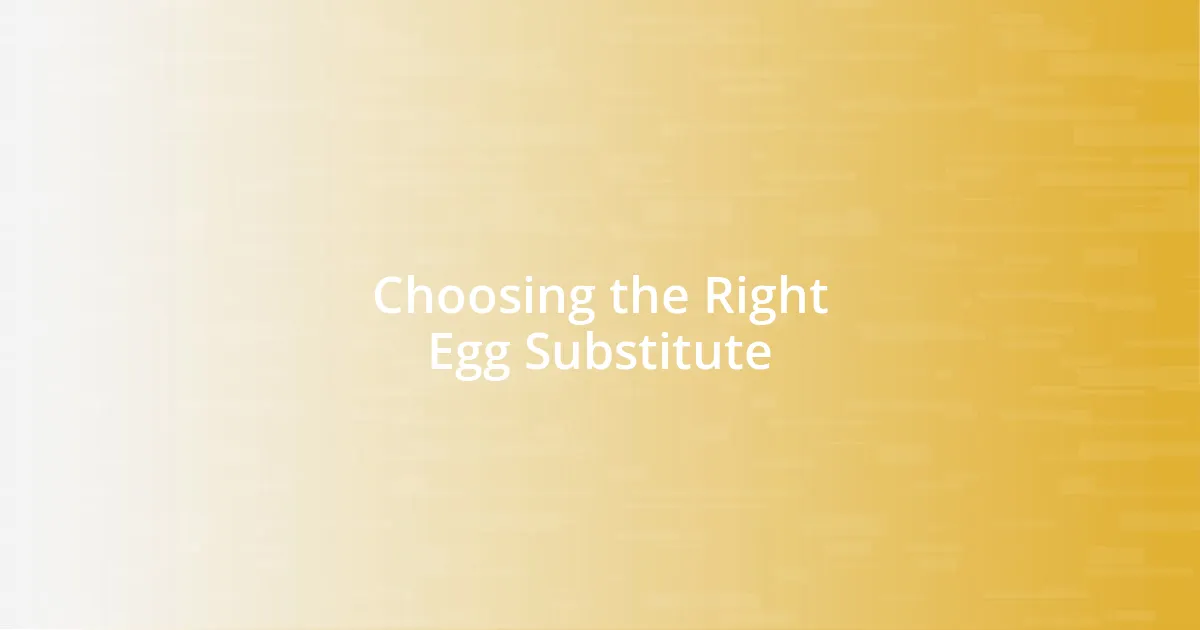
Choosing the Right Egg Substitute
Choosing the right egg substitute can truly transform a vegan baking experience. I remember attempting a classic sponge cake and using mashed bananas instead of eggs. The result was a beautifully moist cake with a hint of natural sweetness that my family devoured without even realizing it was egg-free. It felt like a small victory, proving that creativity can yield delicious outcomes!
Another time, I experimented with silken tofu, blending it into a smooth purée and incorporating it into a decadent brownie recipe. I was pleasantly surprised by how well it held the ingredients together while adding a subtle richness. It felt incredible to savor a dessert that was satisfying in texture and flavor, reminding me that vegan baking can be incredibly versatile.
However, choosing the right substitute often depends on the recipe. A cookie recipe may call for something entirely different than a cake. This flexibility gives me the chance to explore various combinations and find what works best. It truly is about knowing your ingredients and their characteristics; that’s where the magic lies!
| Egg Substitute | Best Used For |
|---|---|
| Flaxseed Meal | Binding in cakes, muffins, and pancakes |
| Aquafaba | Whipping for meringues and light desserts |
| Mashed Banana | Adding moisture in breads and sweet treats |
| Silken Tofu | Rich and moist desserts like brownies |
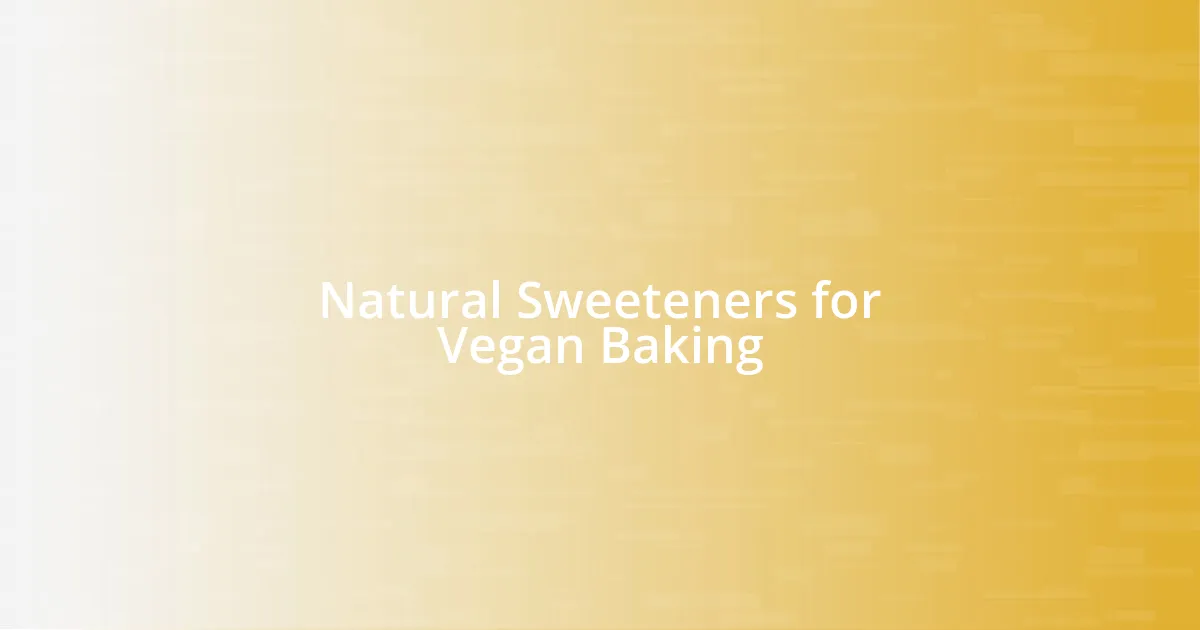
Natural Sweeteners for Vegan Baking
Natural sweeteners have become my go-to allies in vegan baking, bringing both flavor and a sense of wholesome goodness. When I first tried using maple syrup in my pancakes, I was amazed by the depth of flavor it added. It wasn’t just about sweetness; it brought a rich, earthy undertone that felt like a cozy embrace. Since then, I often find myself reaching for it, especially when I want to elevate simple recipes.
Then there’s agave nectar, which I discovered when experimenting with cookies. I remember baking a batch on a whim, using agave instead of refined sugar. The resulting cookies were wonderfully chewy, with a subtle sweetness that my friends couldn’t resist. The best part? They didn’t even notice the absence of white sugar. Isn’t it thrilling when a substitution not only works but enhances your treats?
Lastly, I adore using dates as a natural sweetener; they’re like little nuggets of caramelized bliss. Blending them into a smooth paste has become my secret weapon in brownies. The rich flavor and texture they impart is simply unmatched, making it feel like I’m indulging in something truly decadent. Have you ever felt the joy of surprising others with a dessert that’s not just delicious but also packed with nutrition? It’s moments like these that reaffirm why I love experimenting with natural sweeteners in vegan baking.
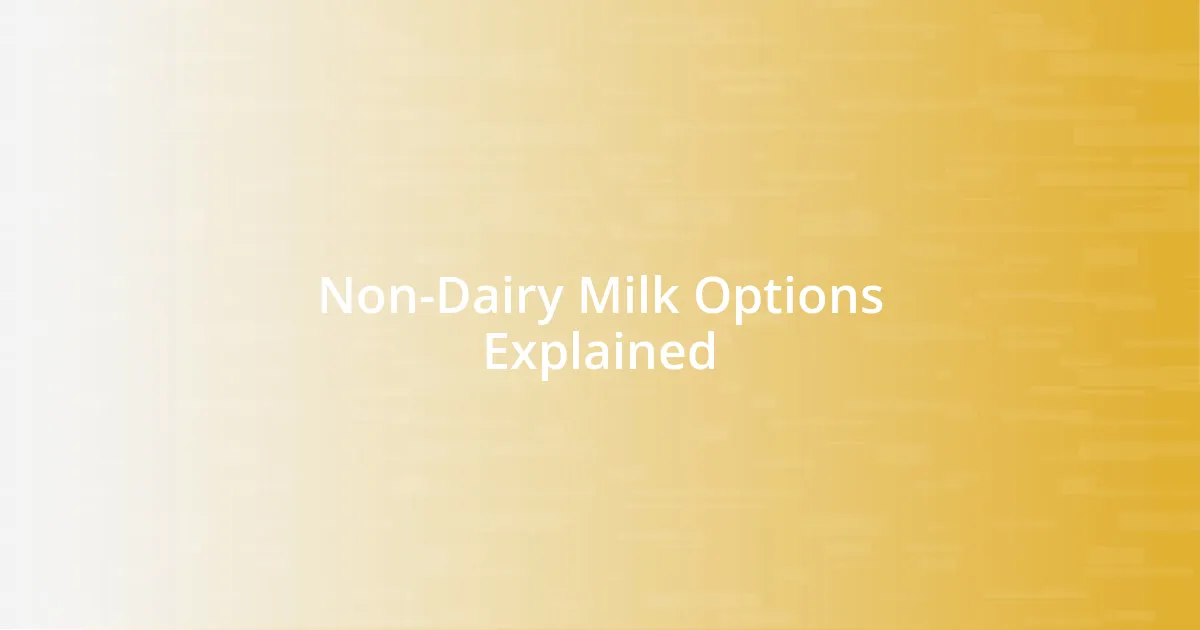
Non-Dairy Milk Options Explained
When I first ventured into non-dairy milk alternatives, I was taken aback by the variety available. Almond milk quickly became a staple in my kitchen because of its subtle nutty flavor. I remember pouring it into my smoothie one morning and feeling a sense of happiness—an invigorating start to my day without the discomfort of dairy.
On another occasion, I decided to try oat milk in my baking. The creaminess and slightly sweet flavor charmed me, especially when I pour it into my oatmeal chocolate chip cookies. It was a game-changer; the cookies turned out chewy and delightful, with an unexpected richness that had my family asking for seconds. Have you ever had that moment when a simple switch transforms the entire recipe?
I recently discovered coconut milk, and it quickly stole my heart with its tropical essence. I love using it in rich desserts, like custards, where its creamy texture enhances each bite. The delightful taste always makes me feel like I’m indulging in a little slice of paradise—who wouldn’t want to experience that in their baking? These options have truly expanded my horizons and creativity in the kitchen.

Essential Flours for Vegan Recipes
When it comes to essential flours for vegan recipes, I’ve found that whole wheat flour is a fantastic choice. The first time I baked bread using it, I was pleasantly surprised by the nutty flavor and hearty texture. It felt good knowing I was incorporating more fiber into my diet while enjoying every warm slice fresh from the oven. Have you tried using it in pancakes? I promise the contrast with maple syrup is pure bliss.
Another favorite of mine is almond flour. I remember making my first batch of vegan brownies with it, admiring the delicate crumb and slight nutty sweetness. The experience was transformative; these brownies didn’t just taste good—they felt indulgent, yet I knew they were made with wholesome ingredients. Have you ever had that moment where a recipe just “comes alive”?
Then there’s coconut flour, which has its own unique charm. I recall experimenting with it in a vegan muffin recipe and being amazed at how absorbent it is. A little goes a long way! The muffins turned out wonderfully moist, with a light coconut aroma that transported me to a tropical getaway. Want to elevate your baking? Incorporating coconut flour is definitely a move I recommend, and each bite feels like a little piece of heaven in your mouth!
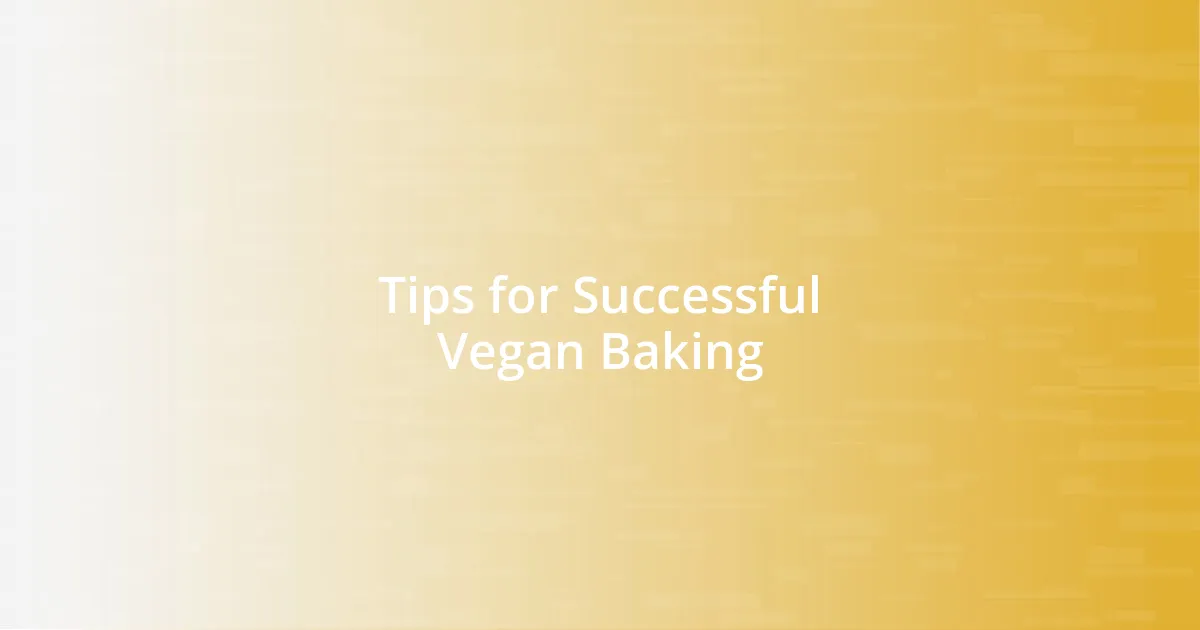
Tips for Successful Vegan Baking
For me, understanding the importance of temperature in vegan baking was a game-changer. I remember the first time I made a vegan cake that fell flat—literally! I hadn’t considered that my ingredients should be at room temperature. Once I started letting my non-dairy butters and milks warm up, the difference was astonishing. Have you ever noticed how a simple tweak can lead to a whole new level of deliciousness?
Another tip I’ve learned along the way is to trust my instincts when it comes to sweetness. I often start with less sugar than a recipe calls for, adjusting based on the ingredients and the flavors I’m working with. On one occasion, while crafting a mango coconut loaf, I felt the natural sweetness of the mango would suffice. Lo and behold, the result was delightful—a perfectly balanced treat that didn’t overwhelm my taste buds. Have you ever created something that surprised you with how well it turned out?
Lastly, pay close attention to your baking time. Vegan treats can be a bit unpredictable, and my first batch of cookies taught me that the toothpick test is my best friend. I recall pulling those cookies out a couple of minutes early, had a slight fear they wouldn’t set properly, but they ended up perfectly chewy! Are you ready to embrace that bit of uncertainty? Sometimes, the best results come from trusting the process and enjoying the ride!










